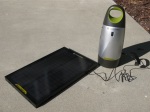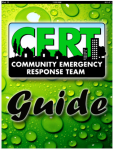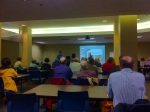Fire season is fast approaching and there are a lot of good ideas on planning for evacuations in case you home is threatened. The wildfires here in San Diego have taught us a valuable lesson, you don't have to live out in the backwoods to have your house threatened. Fires can strike anywhere and any time so it is important to have an evacuation plan ready. There really are no right or wrong evacuation plans - except for not having any plan at all.
A real-life example of someone not having a plan for evacuation was shown on TV during the 2003 wildfire here in San Diego. The fire had already burned down dozens of homes in the Scripps Ranch suburb when a local camera crew showed a lady leaving her house in an area that had just been ordered to evacuate. She was walking to her car carrying a potted fern. She looked distraught and her car looked otherwise empty as she got in. I remember thinking, she's in shock because of the shear impact of the possibility of losing her home. She had just grabbed the first thing she saw - a potted fern. Who knows how much she lost to this massive wildfire. The image of her getting into her car and driving away with her fern stayed with me for a long time. Surely there had to be some things far more precious to her and which she now sorely misses. If she'd only had a evacuation plan so she didn't have to think about what to take during the middle of the emergency.
Not wanting to end up in the same situation in a future emergency, I started looking around at various evacuation plans for my family such as assigning members of the household to get specific items or having containers marked with things to put in them or already filled with supplies. Each of these plans will work but also have drawbacks for my situation. If someone isn't home for instance, who picks up the items they should have gotten? Finding storage space or rotating supplies are also issues I would rather not have to address. I finally settled on a concept I call a "Bug-Out List". It has some major benefits compared to the other plans. It doesn't make any assumptions on who is at home or how much time you have to evacuate. It doesn't matter if you have 3 minutes, 3 hours or even 3 days to evacuate. It mostly requires you to sit down with your family and create a list of things to get
in order of importance.
To begin building your own Bug-Out list, we should start by thinking about a worst case scenario. Let's assume that you are in bed asleep. When you wake there are no lights or power and it's the middle of a dark, overcast night. A big earthquake could cause something like this and the last thing you want to be doing is stumbling around in the dark.
The first thing you should be able to grab right at your bedside is a good flashlight. Your cell phone can also double as a flashlight in a pinch but three or four D-cell flashlight would work a lot better. Next, hard-soled shoes right at your bedside in case there is glass or other sharp objects on the floor or outside. Quick fact: did you know that cuts to feet by glass was the most common injury in the 1992 LA earthquake?
So far we're only talking a minute or two getting our feet protected and being able to see. Next, you probably want to grab your clothes and jackets. Just grab them - don't stop to put them on if it's dangerous inside but we will need them if we have to go outside. Even the warmest evenings can quickly get miserable if we're outside in our pajamas.
Ok, here's our list so far which assumes we only had 3 minutes to evacuate because of an immediate disaster such as fire or earthquake.
1. Flashlight
2. Shoes
3. Clothes
4. Jackets
Now let's change the evacuation time to 30 minutes and add to our list more items in order of importance. Once we've escaped the immediate danger, we now need to concern ourselves with any injuries you have and staying healthy. So to my list I add the first aid supplies I have ready to go and all the prescription medicines my family will need. Hopefully, enough medicine to last three days or more because in a major event, we may not see help for 72 hours or more.
5. First Aid Kit
6. Prescription Drugs
We now have to consider the survival triangle: Water, Food and Shelter. Initially, shelter and water are going to be the most important of the three sides, food will become important later on. Shelter from the elements is usually first but if you are in a very hot climate water could well be of prime importance. So the next things on our list should address shelter, water and then food. First, personal shelter in the form of blankets, and to that we will add bath towels. Towels can be used as an improvised hoodies if you need to keep warm, in additional to their more classic uses. You may also want to have space blankets because they are waterproof in addition to being warm. Next, shelter! My family has a lot of camping gear which will shelter us if we cannot return to our house and there aren't any other shelter options available. Your family may have a travel trailer or motor home or even a storage shed out back might work with a little preparation.
So here are my additions to my list.
7. Blankets
8. Towels
9. Camping Tents
10. Camp Heaters
11. Camp Stove
12. Matches
13. Firestarters
14 Water
15 Non- perishable foods: canned goods, dried pasta and beans.
16.Pet food
Food, water and shelter have all now been addressed. Probably within the 30 minutes you had available to evacuate too!
With hours or even days of time available, you could get some less obvious items onto your "Bug-out List" such as a camp toilet, toilet paper and sanitary items to go with it which you might need if help is delayed. Radios, batteries, laptop computers and computer backup drives will be useful to get information and to be able to recover financial and property data afterwards. My list has almost 200 items goes as far as our photo albums, stamp collections, artwork and musical instruments. For instance, I can load the piano and TV's and artwork into the trailer if there's a day or more time to evacuate.
In conclusion, you can make the list cover just a few items or virtually your entire house depending on how far you wish to take it. But if something happens, all you have to do is tell whoever is there at the house to keep going down the list until you are told you have to evacuate. That way you won't be grabbing a potted fern in desperation like that lady. You will be certain that you gotten everything you had time to get and that you didn't leave anything important behind.
I welcome your comments and any evacuation plans you would like to share with us.
TJ Walters














